
The right to live should be far more important than the right to work, and labor safety is the most crucial labor condition that the Group and its employees must jointly strive to maintain. As an employer, our company considers Eurocharm Cayman personnel as company representatives coordinating with clients; thus, we do not disclose occupational safety and health management information. Eurocharm TW Xinzhuang factory does not meet the scale requirement stated in the Occupational Safety and Health Act, which mandates the establishment of an occupational safety and health management system for businesses with 200 or more workers in the first category of industries. Nevertheless, the Company has established internal procedures such as “The Procedure Book for Hazard Identification, Risk Assessment, and Determining Control Measures,” “Hazard Awareness Program,” “Work Environment Measurement and Sampling Strategy Planning,” “Automated Inspection Management,” “Employee Health Management,” “Contractor Safety and Health Operation Regulations,” “Change Management Operation Regulations,” and “Personal Protective Equipment Management.” However, internal and external audit were not conducted. VPIC1 in Vietnam has a safety office to implement an occupational safety and health management system. We comply with labor laws and regulations, fulfill our corporate responsibilities, and take care of and protect our employees. We have established safety and health/environmental policies and labor safety and health guidelines, and we hold labor safety and health meetings every quarter. Employees should have an understanding of occupational safety and health regulations that are closely related to them and are obligated to comply with them to ensure their own safety at work. VPIC1 in Vietnam has obtained ISO 14001:2015 Environmental Management System and ISO 45001:2018 Occupational Health and Safety Management System certifications. In 2024, three safety and environmental-related procedures were newly added or revised. A management review meeting was held on July 6, 2024, and an external audit was successfully passed on July 26, 2024. This system covers all 4,477 employees of VPIC1 in Vietnam (100%) and 162 non-employee workers (100%). The procurement, development, construction, production, maintenance, and contracting processes fully comply with the requirements of ISO 14001:2015 and ISO 45001:2018.
Safety and Health Policies
- Focus on global safety and health issues, assess risks, and build a safe working environment.
- Actively communicate and cooperate with customers and suppliers to improve the safety and health performance of our supply chain.
- Follow and comply with domestic and international laws and regulations, such as fire prevention, environmental protection, and safety and health laws.
- Continuously promote environmental safety and hygiene improvements to create a safe and healthy workplace.
- Identify blind spots and constantly improve through continuous auditing activities and safety and health management reviews to enhance operational safety and environmental quality.
Hazard Risks Assessment
Disasters are commonly perceived by the public as unexpected or unplanned catastrophic events. However, in safety management, a disaster is understood as a process that begins with the event and unfolds chronologically toward an outcome. Due to the numerous factory facilities and frequent human-machine interactions, implementing autonomous safety inspections to prevent equipment failures and human errors has always been a crucial issue in occupational safety. In 2024, Eurocharm TW identified 1 high-risk item (forklift crushing injuries), 5 medium-high-risk items, and 2 medium-risk items. Regular retraining for forklift operators is conducted to address the high-risk item. VPIC1 in Vietnam conducts regular identification of occupational hazards and risk assessments based on the “Hazard and Risk Assessment Procedure,” continuously and proactively identifying hazards and assessing risks in various operational activities, products, and service processes for potential occupational safety and health hazards. In 2024, 15 high-risk items were identified (such as elevator/crane cable or chain breakage, collisions, brake hook to cable/chain failure, crushing injuries, electric shock, splash of mold/spring/parts, etc.), along with 62 medium-risk items and 17 low-risk items. These are assessed to identify occupational safety and health risks and opportunities, with the goal of achieving zero accidents. Through continuous hazard identification and risk assessment, the company identifies opportunities to eliminate or reduce occupational safety and health risks, thereby implementing its safety and health policy and fulfilling the requirements for continuous improvement. Work environment monitoring is carried out to understand the actual on-site conditions and assess worker exposure through planning, sampling, analysis, or measurement, in order to develop appropriate strategies. In 2024, VPIC1 in Vietnam conducted environmental monitoring on noise, respirable dust, carbon dioxide, carbon monoxide, xylene, toluene, illuminance, humidity, and temperature, with a total of 767 samples measured. Among them, 618 samples (including noise, respirable dust, oxygen, carbon dioxide, xylene, toluene, illuminance, humidity, and temperature) met the standards, while 47 noise samples, 13 illuminance samples, and 89 temperature samples failed to meet the standards. For non-compliant items, lighting and ventilation were immediately improved, and the company strictly required employees to wear earplugs to mitigate the impact of noise. VPIC1 in Vietnam provides employees with earplugs and earmuffs and conducts regular special health examinations to ensure proper health care for its workers.

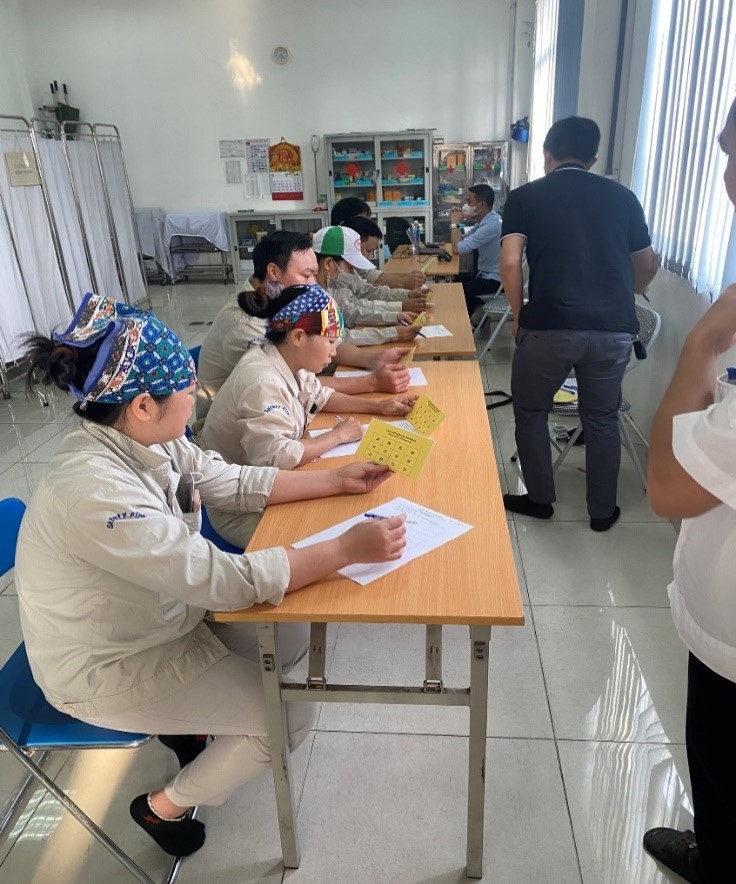
The Procedure of Risk Assessment
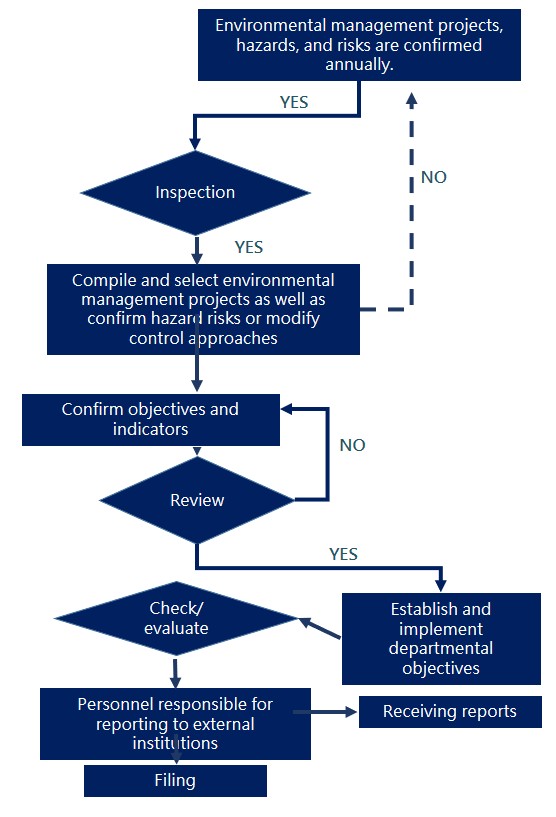
| Activity/ Equipment | Items with High Risks | Control Measures |
|---|---|---|
| Freight elevators/ Lifts | Falling of an elevator that injures employees | ● Inspect according to the elevator checklist. ● The system is equipped with a safety door. If the door is not closed, the freight elevator cannot operate. While in operation, the door cannot be opened unless the elevator reaches the first floor, ensuring safety. ● Add a locking mechanism to the control room when the elevator descends. ● Install an inner door guide panel. ● Install a load limiter. ● Upgrade the control panel: It only includes automatic operation and emergency stop buttons (manual control buttons are locked and only used during maintenance). |
| Cranes | Cable or chain breakage | ● Employees must undergo training and hold professional licenses. ● Inspect according to the crane inspection checklist. ● Follow cable/chain load regulations. ● Manufacture additional C-hooks with a load capacity of 5-7 tons. ● Develop operation instructions for the hooks. ● Conduct regular maintenance and safety inspections. |
| Cranes | Collision when moving products/materials | ● Employees must undergo training and hold professional licenses. ● Use protective equipment (safety helmets). ● Equip cranes with warning lights during operation. |
| Cranes | The crane cable/chain slipped out of the locking hook. | ● Employees must undergo training and hold professional licenses. ● Inspect according to the daily crane and cable inspection checklist. ● Regularly inspect, maintain, and replace damaged equipment to ensure safety. |
| Forklifts | Collision with people | ● Employees must undergo training and hold professional licenses. ● Install flashing lights, horns, and alarms. ● When the forklift is moving, maintain a safe distance of at least 60 cm from the assistant, and regularly inspect, maintain, and replace damaged equipment. Additionally, operators must participate in the annual forklift safety driving skills test. ● Speed controlled at 5 km/h (inside the die-casting production line). |
| Shearing Machine | Entrapped/jammed boards | ● Use protective equipment. ● Issue safety cards to trained employees. ● Follow the Company’s guidelines for the shearing machine. ● Inspect according to the daily equipment checklist. ● Create a workbench with rollers for placing materials and place corrugated iron supports behind the automatic machine. ● Install fences and partitions around the corrugated iron cutting machine. ● Add four stop positions to the fence. |
| Punching Machine | Entrapped/jammed boards | ● Install sensors. ● Install dual-hand press device. ● Install emergency stop buttons. ● Install an operating device on each press machine. ● Eye examination chart, physical and mental health equipment, etc. |
| Punching Machine | Splashing of molds/springs/parts | ● Provide protective gears: goggles, masks, etc. ● There are protective shields around the molds. ● There are protective shields by, in front of, and behind the machine. ● Develop detailed instructions for mold disassembly and assembly. |
| Table Saw | Electric shock caused by electricity leakage | ● Inspect according to the daily equipment checklist. |
| Molding Machine | Entrapped/jammed boards | ● Install doors and safety relays. ● Safety locks and emergency stop buttons. |
| Deburring Machine | Entrapped/jammed boards | ● Install electrical relay and safety sensor. ● Install fences. ● Interlock devices. ● Lightning equipment. ● Inspect according to the daily equipment checklist. ● The supportive bars when changing molds. |
| Molds | Mold damages and splashing parts | ● Employees must wear protective equipment (safety goggles) properly. |
| Self-owned stamping machine | Entrapped/jammed boards | ● Separate the areas of human and machine activities within the safety zone. |
| Trucks | Collision with people or vehicles | ● Comply with traffic safety regulations. ● Regularly check, maintain, and replace damaged equipment. ● Install dashcams. |
Prevention of Occupational Safety Impacts
The Company values contractors as important partners. To ensure the safety of our contractors, each production site abides by the local occupational safety and health laws and regulations, reviews contractor construction plans, and requires suppliers or customers to wear protective equipment when entering the factory. We also promote various management mechanisms to strengthen contractor construction safety, such as complying with the table of contractor management (including equipment operation training records/professional licenses), and regularly or randomly inspect construction safety during construction processes. A contractor qualification review system is in place to classify contractors by their service projects while establishing a list of qualified contractors. This system will help procurement units to have an initial understanding of contractor backgrounds while also meeting practical needs such as improving the operation quality and construction safety standards. At VPIC1 in Vietnam, each production shift is assigned one safety officer, responsible for inspecting equipment and fire safety according to the checklist. The safety department conducts a weekly factory tour to identify deficiencies and reports them for on-site adjustments, and the feedback are provided upon improvements. The management department inspects one factory area each week, records deficiencies, and reports them for on-site adjustments. In 2024, Eurocharm TW took the initiative to conduct inspections on a total of 46 registered machines, all of which were carried out in accordance with Chapter 4 of the Occupational Safety and Health Management Regulations. Regular inspections were also conducted to ensure the safe operation of the equipment. Operators of hazardous equipment receive regular external safety and health education and training. In 2024, Eurocharm TW conducted labor safety education and training for employees, totaling 106 hours. The training content included general labor safety management, forklift, overhead crane, as well as hazard risk analysis management, etc. A total of 24 employees participated, representing a 26% increase from the training hours in 2023. In 2024, VPIC1 in Vietnam conducted labor safety education and training for employees, totaling 11,978 hours. representing a 31% increase from the training hours in 2023. A total of 5,064 employees participated, with training content including general labor safety management, forklift operation, overhead crane operation, and hazard risk analysis, etc. Referring to international regulations, customer requirements, and environmental trends, we have established a registry for 236 chemicals in use.
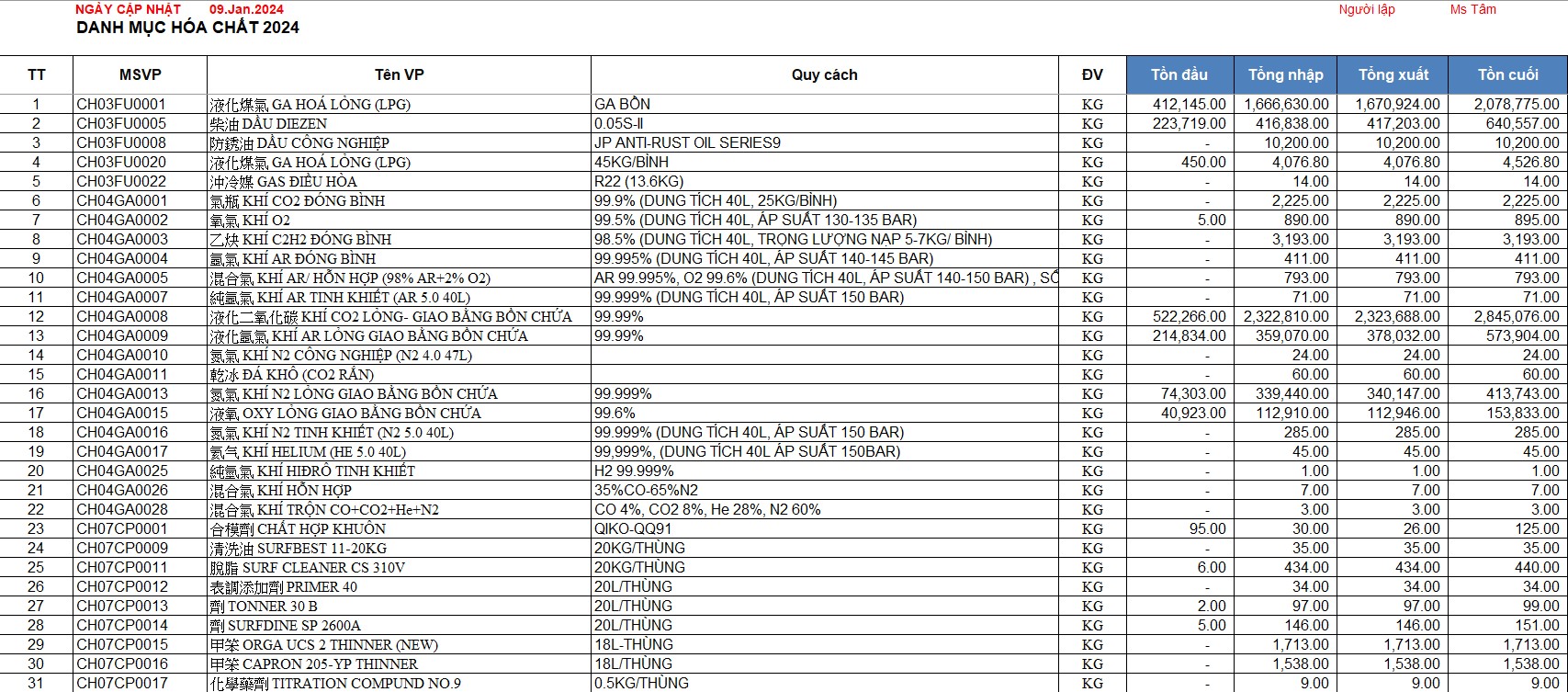
Safety Dojo (Training Center)
Vietnam VPIC1 has established a Safety Dojo at the Baishan plant. The term “dojo” originates from Japanese and refers to a training place. The Safety Dojo has become an excellent venue for employees to learn numerous important safety courses. The training conducted at the dojo mainly covers safety, quality, and environmental protection. Safety Dojo education is an experiential safety education method. By simulating scenarios such as being stroked by objects, fingers being caught in a stamping press, and safety shoes being crushed, employees can effectively combine “listening, observing, and doing” through watching, participating, and experiencing. This helps them gain a deeper understanding of the dangers and consequences of safety incidents and enhances their awareness of the importance of safety on an emotional level.
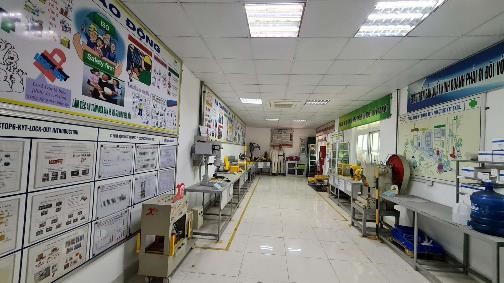
Notification and Investigation Mechanism for Occupational Hazards
Eurocharm TW and VPIC1 in Vietnam supervise the handling of occupational accidents in accordance with local regulations, conduct statistical analysis of occupational accidents to promptly understand the status of employee occupational accidents. When an occupational accident occurs, the management department and occupational safety unit immediately initiate an accident investigation, conduct accident investigation analysis, and propose improvement measures. They regularly promote relevant safety and health matters to prevent similar situations from happening again. In 2024, VPIC1 in Vietnam experienced a total of 6 occupational accidents, mostly related to crushing injuries. Apart from establishing relevant operational regulations and enhancing education and awareness, necessary safeguards were also implemented for potentially dangerous machinery and equipment. Efforts were made to actively and properly handle injuries caused by employee accidents and assist employees in returning to the workplace.
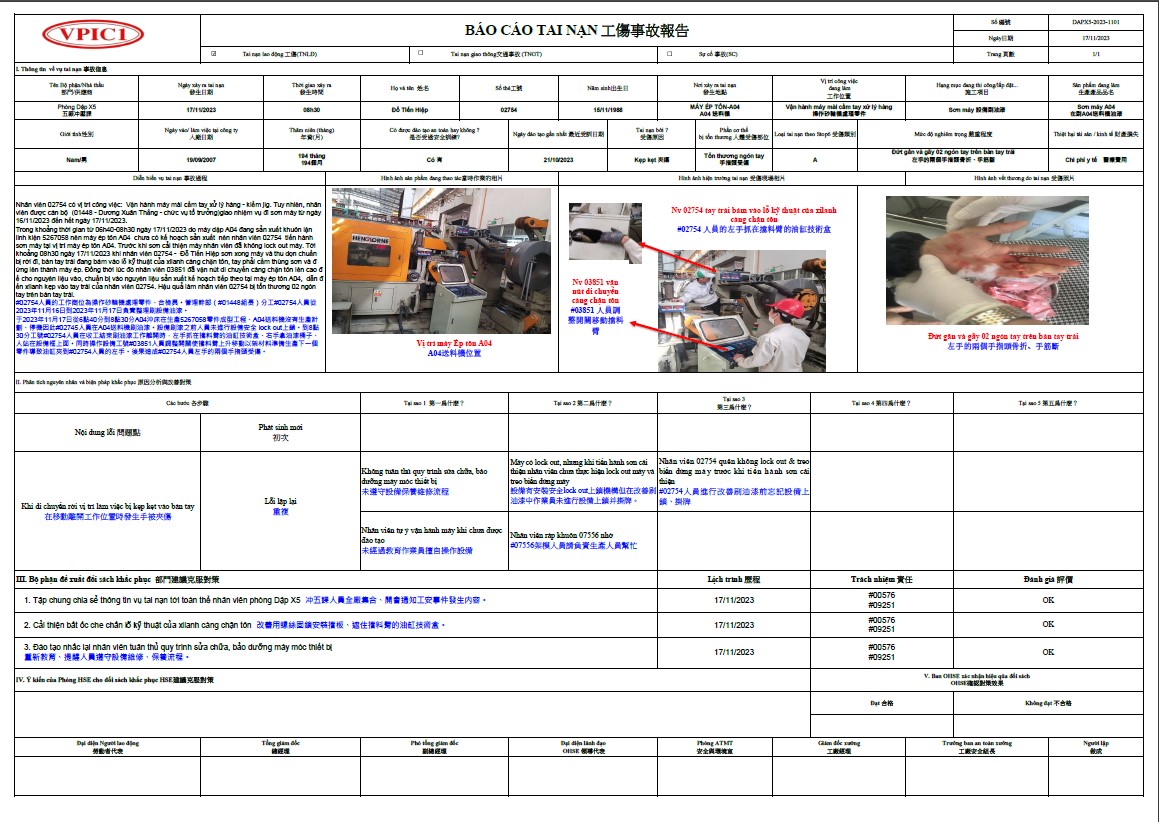
The Investigation Procedure for Occupational Injuries

The Investigation Procedure for Fire Accidents
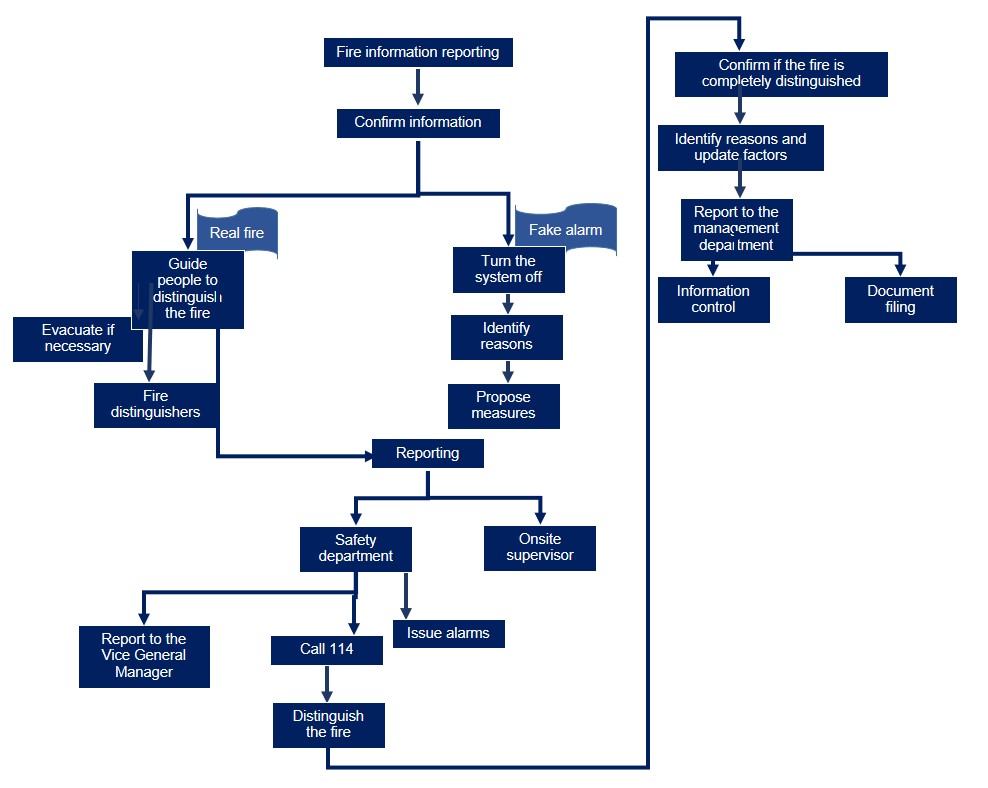
The Investigation Procedure of Chemical Leaks Accidents

The Investigation Procedure of Food Poisoning Accidents
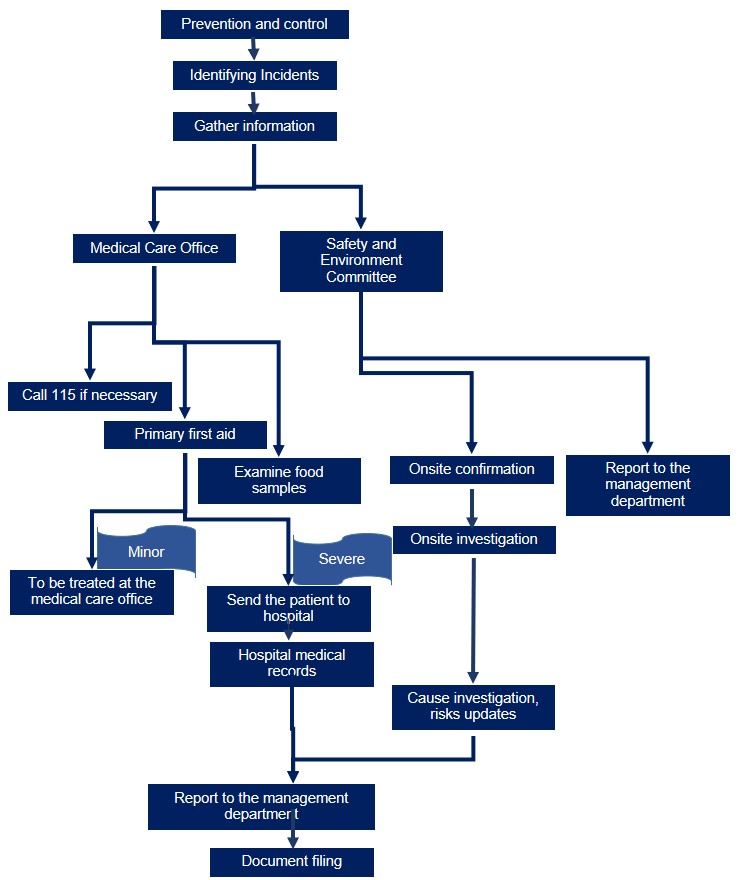
The Investigation Procedure of Contagious Diseases
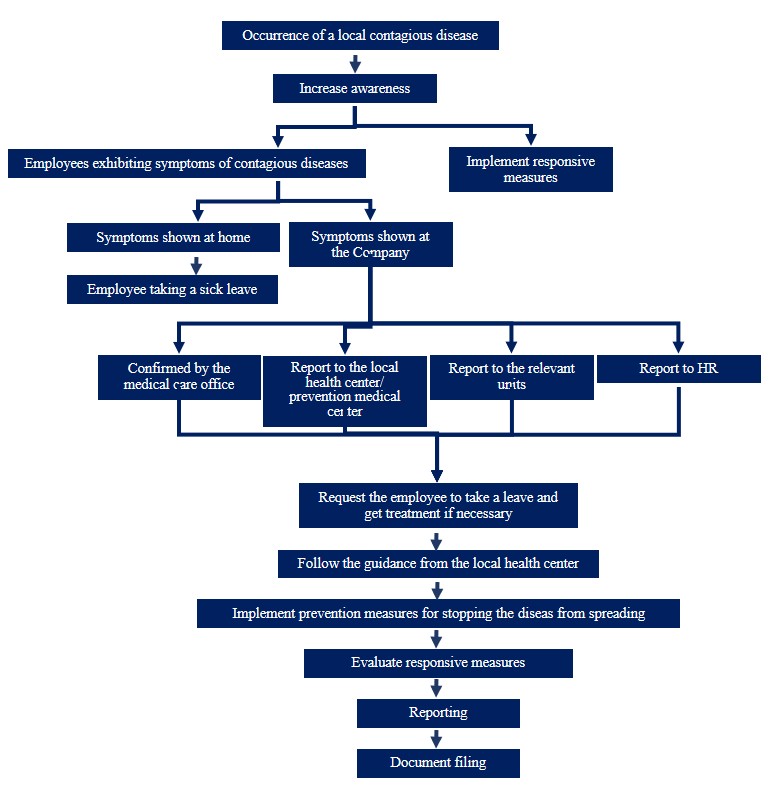
Statistics of Occupational Injuries in Taiwan
| Item | 2022 | 2023 | 2024 |
|---|---|---|---|
| Number of Occupational Injury Cases | 0 | 0 | 0 |
| Serious Injuries | 0 | 0 | 0 |
| General Injuries | 0 | 0 | 0 |
| Number of Work-Related Deaths | 0 | 0 | 0 |
| Rate of Work-Related Deaths | 0 | 0 | 0 |
| Number of Recordable Occupational Injuries | 0 | 0 | 0 |
| Recordable Occupational Injury Rate | 0 | 0 | 0 |
| Injury Rate (IR) | 0 | 0 | 0 |
| Lost Day Rate (LDR) | 0 | 0 | 0 |
| Injury Frequency Rate (FR) | 0 | 0 | 0 |
| Injury Severity Rate (SR) | 0 | 0 | 0 |
(Note) The total working hours in Taiwan was 72,690.5 hours, the sum of the employees’ actual hours of attendance (including overtime hours).
(Note) Injury Rate (IR) = (the total number of occupational injury cases / total working hours) x 200,000.
(Note) Lost Day Rate (LDR) = (lost days/ total working hours) x 200,000. Lost days does not include the day of injury and the day of returning to work.
(Note) Recordable Occupational Injury Rate: Recordable occupational injury cases (including minor injuries, serious injuries, and fatalities) × 1,000,000 ÷ total working hours.
(Note) Rate of work-related death = the number of work-related deaths / total working hours x 200,000
(Note) Injury Rate (IR), Lost Day Rate (LDR), and the rate of work-related deaths are calculated based on 40 working hours per week, 50 weeks per year, per 100 employees.
(Note) Injury Frequency Rate (FR) = (number of disabling injuries throughout the year / total working hours) × 1,000,000
(Note) Injury Frequency Rate is equivalent to the GRI-defined recordable occupational injury rate.
(Note) Injury Severity Rate (SR) = (total lost days due to disabling injuries throughout the year / total working hours) × 1,000,000
Statistics of Occupational Injuries in Vietnam
| Item | 2022 | 2023 | 2024 |
|---|---|---|---|
| Number of Occupational Injury Cases | 9 | 7 | 7 |
| Serious Injuries | 0.0690 | 0.118 | 0.084 |
| General Injuries | 0.0863 | 0.047 | 0.033 |
| Number of Work-Related Deaths | 0 | 0 | 0 |
| Rate of Work-Related Deaths | 0 | 0 | 0 |
| Number of Recordable Occupational Injuries | 9 | 7 | 7 |
| Recordable Occupational Injury Rate | 0.776 | 0.827 | 0.587 |
| Injury Rate (IR) | 0.155 | 0.165 | 0.117 |
| Lost Day Rate (LDR) | 3.43 | 5.30 | 2.67 |
| Injury Frequency Rate (FR) | 0.35 | 0.59 | 0.42 |
| Injury Severity Rate (SR) | 16.82 | 27.30 | 13.91 |
(Note) The definition of serious injuries for Vietnam companies is events that caused disability.
(Note) The total working hours in Vietnam was 11,933,627 hours, the sum of the employees’ actual hours of attendance (including overtime hours).
(Note) Injury Rate (IR) = (the total number of occupational injury cases / total working hours) x 200,000.
(Note) Lost Day Rate (LDR) = (lost days/ total working hours) x 200,000. Lost days does not include the day of injury and the day of returning to work.
(Note) Recordable Occupational Injury Rate: Recordable occupational injury cases (including minor injuries, serious injuries, and fatalities) × 1,000,000 ÷ total working hours.
(Note) Rate of work-related death = the number of work-related deaths / total working hours x 200,000
(Note) Injury Rate (IR), Lost Day Rate (LDR), and the rate of work-related deaths are calculated based on 40 working hours per week, 50 weeks per year, per 100 employees.
(Note) Injury Frequency Rate (FR) = (number of disabling injuries throughout the year / total working hours) × 1,000,000
(Note) Injury Frequency Rate is equivalent to the GRI-defined recordable occupational injury rate.
(Note) Injury Severity Rate (SR) = (total lost days due to disabling injuries throughout the year / total working hours) × 1,000,000
Statistics of Occupational Injuries of the Contractor Employees
| Item | 2022 | 2023 | 2024 |
|---|---|---|---|
| Number of Occupational Injury Cases | 0 | 1 | 0 |
| Serious Injuries | 0 | 0 | 0 |
| General Injuries | 0 | 1 | 0 |
| Number of Work-Related Deaths | 0 | 0 | 0 |
| Rate of Work-Related Deaths | 0 | 0 | 0 |
| Number of Recordable Occupational Injuries | 0 | 1 | 0 |
| Recordable Occupational Injury Rate | 0 | 10.320 | 0 |
| Injury Rate (IR) | 0 | 2.064 | 0 |
| Lost Day Rate (LDR) | 0 | 4.128 | 0 |
| Injury Frequency Rate (FR) | 0 | 0 | 0 |
| Injury Severity Rate (SR) | 0 | 30.960 | 0 |
(Note) The definition of serious injuries for Vietnam companies is events that caused disability.
(Note) Injury Rate (IR) = (the total number of occupational injury cases / total working hours) x 200,000.
(Note) Lost Day Rate (LDR) = (lost days/ total working hours) x 200,000. Lost days does not include the day of injury and the day of returning to work.
(Note) Recordable Occupational Injury Rate: Recordable occupational injury cases (including minor injuries, serious injuries, and fatalities) × 1,000,000 ÷ total working hours.
(Note) Total working hours for contractors in Taiwan = Average of 4 equipment suppliers entering × 2 technicians × 4 hours spent in the company × 7 working days = 224 hours, which is the total attendance hours (including overtime hours).
(Note) Total working hours for contractors in Vietnam = Average of 160 vehicles entering daily × 2 hours spent in the company × 283 working days = 90,560 hours, which is the total attendance hours (including overtime hours).
(Note) Rate of work-related death = the number of work-related deaths / total working hours x 200,000
(Note) Injury Rate (IR), Lost Day Rate (LDR), and the rate of work-related deaths are calculated based on 40 working hours per week, 50 weeks per year, per 100 employees.
(Note) Injury Frequency Rate (FR) = (number of disabling injuries throughout the year / total working hours) × 1,000,000 (Note) Injury Frequency Rate is equivalent to the GRI-defined recordable occupational injury rate.
(Note) Injury Severity Rate (SR) = (total lost days due to disabling injuries throughout the year / total working hours) × 1,000,000
Employees’ Work-related Incidents
| Severity of the Injury | Description of the Incidents | Improvement Measures |
|---|---|---|
| Severe | On February 29, 2024, while performing pipe bending operations in the stamping department, an employee was injured. Due to the weight of the part, it had to be supported by hand after the bending process. During this time, the employee was not paying full attention and placed their hand between the cylinder and the part, resulting in it being caught and injured. | Share this workplace injury case to emphasize that employees must operate machinery strictly according to procedures and must not lose focus. Supervisors should immediately correct any signs of inattentiveness during inspections, and if the situation is serious, disciplinary actions should be taken. |
| Severe | On March 18, 2024, an employee in the welding department was using a hammer to strike parts during inspection with a fixture. During the process, the employee failed to follow regulations and did not wear safety goggles, resulting in a foreign object striking the left eye and causing a workplace injury. | Establish a surface inspection standard for hammers, requiring inspections to be conducted before each shift begins. Employees must use personal protective equipment (PPE) as required. Those who fail to comply will be subject to disciplinary action. |
| Severe | On March 28, 2024, four employees from the painting department were working together to move a piece of glass measuring 2.2 meters in length and 1.2 meters in width to the second floor of the warehouse. During the process, the glass suddenly shattered. Two employees positioned below sustained cuts to their left forearms and wrists due to rolled-up sleeves, which left their arms exposed. | Promote and strictly enforce safety regulations, emphasizing that employees must not roll up their sleeves while working and must use personal protective equipment (PPE) as required. Supervisors must issue disciplinary action when violations of safety regulations are found during inspections. |
| Severe | On August 10, 2024, an employee from the warehouse department at Plant 4 discovered that the inner door of the second-floor freight elevator was stuck and attempted to fix it on their own. Another employee nearby, who was organizing containers, noticed the situation and came over out of concern. After the elevator issue was resolved, it suddenly dropped to the first floor, causing the employee inside the elevator to fall as well—fortunately, without injury. However, the employee standing at the entrance was startled and fell onto the top of the elevator, resulting in a fractured arm. | Install sensors to ensure that the freight elevator only operates when the inner door is fully closed. Improve the track system of the elevator’s sliding doors to prevent deformation and ensure smooth operation. Prohibit personnel from other departments from operating the freight elevator—only trained warehouse staff are authorized to operate it. |
| General | On October 14, 2024, an employee in the machining department at Plant 1 was operating a drilling machine when they noticed that the distance between the drill bit and the part was too high, resulting in longer processing time. In an attempt to reduce production time, the employee adjusted the travel height without authorization and accidentally got their fingers caught, causing injury. | Re-educate employees, emphasizing that any adjustments to machinery must be communicated to the equipment management or supervisor. Establish a rule that if any parts of equipment are removed for maintenance, clear signage must be displayed to inform others of the situation. |
| General | On October 17, 2024, the team leader in the stamping department used PE film to wrap the leftover steel coils from production. Due to gaps between the layers of steel plates, an employee’s finger was accidentally extended into the gap during the process and was caught and injured when the steel plate rebounded. | When the production planning staff issues a work order, ensure that 8mm/6mm steel coils are fully used up without the need for recovery. When recovering the remaining coils, use tools to securely fix them in place to prevent any rebound or injury. |
Fire Incident Explanation
| Description of the Incidents | Improvement Measures |
|---|---|
| On October 16, 2024, two employees from Stamping Section 6 were installing a light on a 1200-ton stamping press. During the process, sparks from the acetylene cutting of a patterned steel plate fell into the machine pit beneath the press. The pit contained plastic materials, which ignited and caused a fire. No personnel were injured, and the 1200-ton stamping press continued to operate normally. The property damage was limited to the plastic items that were burned, with an estimated value of 1,400,000 VND (approximately NT$2,000). | Conduct a thorough inspection of all machine pits to ensure that no flammable materials are stored. When using acetylene for construction work, the surrounding area must be cleared of any flammable materials before starting. Additionally, during the operation, a person must be stationed in the machine pit to act as a lookout and ensure safety. |



